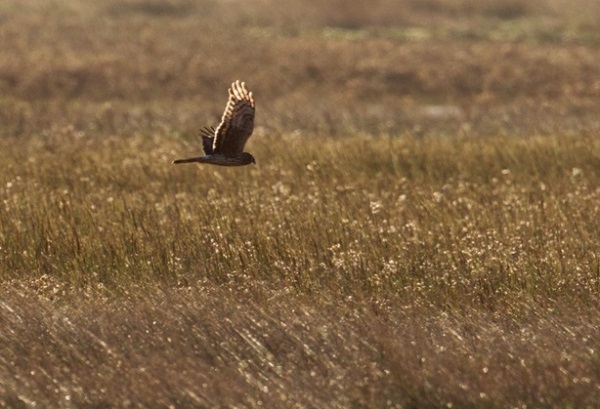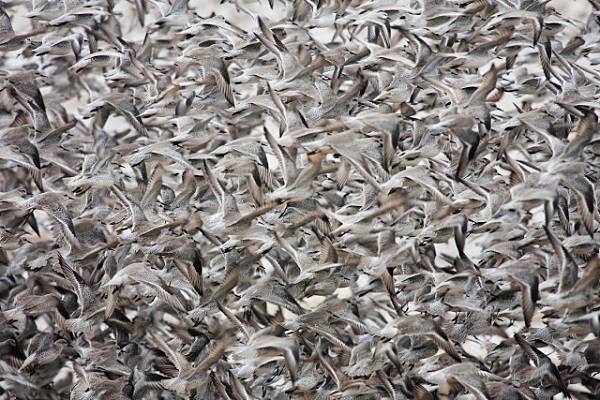Site menu:
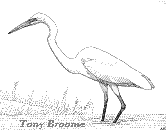
December 2013 Newsletter
Species Spotlight - Great White Egret.
November Bird News.
Forthcoming Events.
Latest Newsletter.
Species Spotlight - Great White Egret
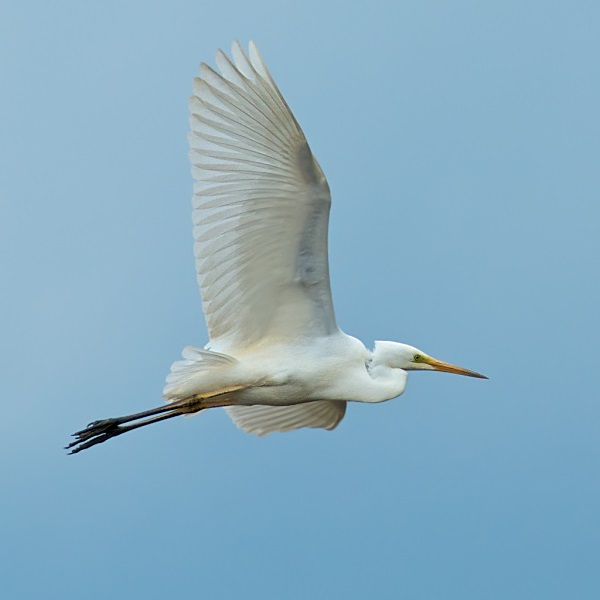
When I first started this website in
1998 Little Egrets were just starting to get established on the
estuary. Having previously been vagrants, then irregular visitors, in
1998 for the first time one or two were present for most of
the year. Just 15 years later
we have over 400 present and 70 pairs breeding! Now a similar pattern
is emerging with Great White Egrets, not that I expect we will ever get
over 400 here, although flocks of that size are not unknown in their
core areas so it isn't impossible. But in 2012 one or two Great White
Egrets were present for most of the year for the first time,
and
it seems likely that records will continue to increase.
The
first Great White Egret into our area arrived on July 25th 1995 at
Inner Marsh Farm, and this was also the first record for the whole of
Cheshire and
Wirral. It was seen again at the same site on July 28th then moved to
Parkgate and spent about three weeks there in August of that year, a
site which was to prove very popular for this species over subsequent
years.
Note: the total number of records shown in the
graph below is the sum of all the daily counts for each year, no
more than one to three birds were present at any one time.
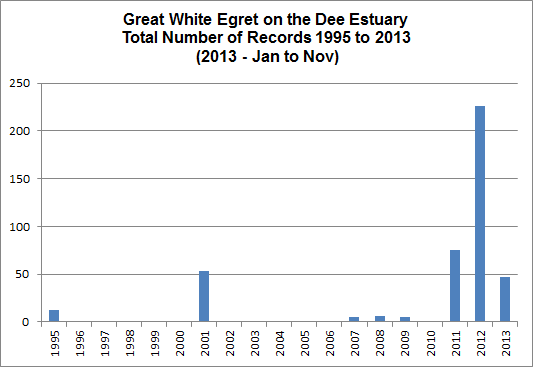
We had to wait six years for the next record with a bird arriving on August 18th 2001 on Flint Marsh, where it stayed for most of the next four weeks before moving to Burton and Neston marshes. As you can tell from the graph it was a long stayer and was last recorded on November 5th. This was the first Dee estuary bird I saw, it was on Burton Marsh and clearly in view from the RSPB Office at Inner Marsh Farm, kindly shown to me by the Wardens.
Over the next 10 years we had just
brief
visits with two records from Burton Marsh, two at Inner Marsh Farm and
one at Gronant in 2007 being typical. All this changed in 2011. The
year started very quietly and there was just the one report of one at
Inner Marsh Farm on May 11th. It, or another, was seen just once in
June at Parkgate and a further three times during the rest of the
summer on Burton Marsh. But from September onwards one was resident
with most reports from Parkgate during the day and at the Burton roost
in the evening or early morning. On October 3rd we had our first ever
multiple record, with two at Parkgate and there were a further 11
reports of two birds that year.
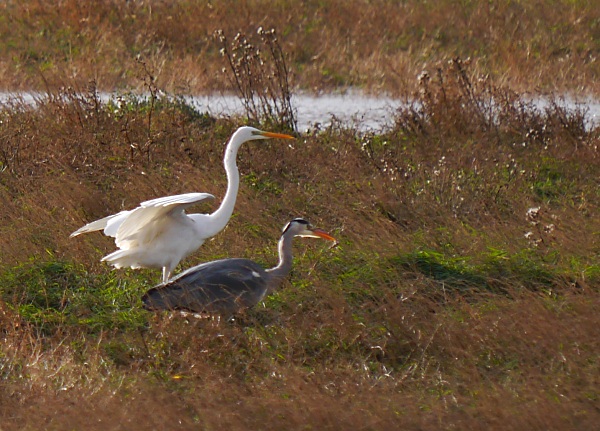
The Great White Egret is the same size as the Heron, a lot bigger than Little Egret
2012 saw birds virtually resident the whole year with a total of 226 records, including 30 of two birds and three of three birds. They were seen all along the English side of the estuary from Burton Mere Wetlands, Burton Marsh to Heswall Marsh and one was even seen, on different dates, flying over Hilbre and Red Rocks. 2013 started well with a similar pattern of records during January and February, and with two present there were high hopes that they would attempt to breed. Then we had that very cold spring and they just disappeared - presumably heading south to warmer climes. Since then there have just been a handful of sightings, but two flew over Little Eye on October 30th heading into the estuary and since then there have been several reports in November and we hope they are here to stay over the winter and into spring.
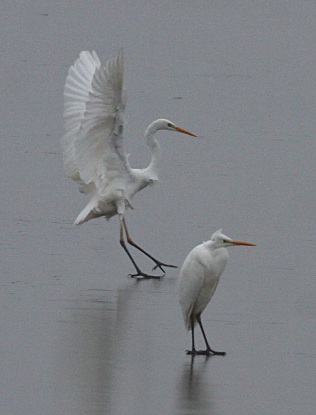 This increase in records
here reflects
a corresponding national increase. It is estimated (Chas Holt)
that there were a total of 60 different birds recorded in the UK in
2011 , an
increase from 10 in 2001 and just two in 1991. Great White Egrets bred
for the first time in this country in 2012 with two pairs on the
Somerset Levels, and they repeated that achievement this year, 2013.
These birds are part of a general movement of this species into
north-west Europe, particularly into France and the Netherlands;
over-wintering numbers in the latter country are now approaching a very
impressive 3,000. This big increase of birds into both
countries has
taken place in just 10 years.
This increase in records
here reflects
a corresponding national increase. It is estimated (Chas Holt)
that there were a total of 60 different birds recorded in the UK in
2011 , an
increase from 10 in 2001 and just two in 1991. Great White Egrets bred
for the first time in this country in 2012 with two pairs on the
Somerset Levels, and they repeated that achievement this year, 2013.
These birds are part of a general movement of this species into
north-west Europe, particularly into France and the Netherlands;
over-wintering numbers in the latter country are now approaching a very
impressive 3,000. This big increase of birds into both
countries has
taken place in just 10 years.
Left: two Great White Egrets standing on ice at Burton Mere Wetlands, Paul Brady.
It will be very interesting to see what happens next. The expectation is for numbers to continue to increase, and this may well include birds breeding locally. A lot depends on the winter weather over the next few years; although the long term forecast is for continuing global warming in the short-term we may well have some colder than average winters. That doesn't necessarily mean fewer birds here, though, as colder weather on the continent may mean birds move further west to the UK and on to the Dee Estuary. We'll just have to wait and see.
Richard Smith.References/Acknowledgements:
1. Cheshire and Wirral Bird Reports 1995 to 2012, CAWOS.
2. Chas Holt, The changing status of the Great White Egret in Britain, British Birds 106: May 2013: 246-257.
3. Steve Barber, Great White Egret in Cheshire and Wirral: Status, Bird News 90, November 2012, CAWOS.
4. Records from www.deeestuary.co.uk, and the many birders who contribute to them.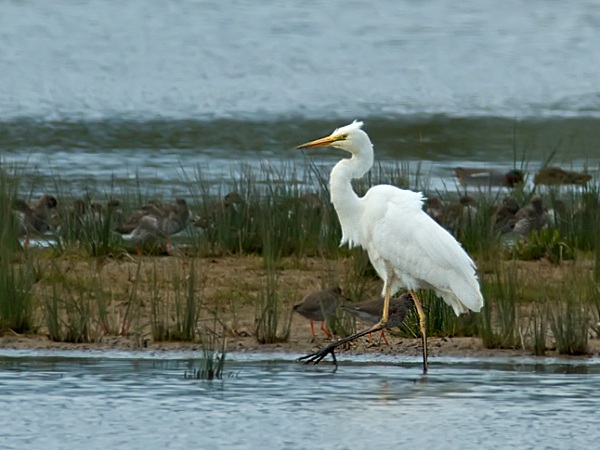
Top of Page
November Bird News
One of the success stories on the estuary has been the rapid increase in Pink-footed Geese in recent years (see Geese on the Dee Estuary article). This year, 2013, there was a count of 4,500 on Burton Marsh in March, followed by at least 5,000 on November 29th - only ten years ago max numbers were typically 150!
The best place to see Twite on the estuary is the Flint and Connah's Quay Reserve area where there were up to 70 during the month. Several of these birds are colour-ringed and I hope to publish an article about these next year.
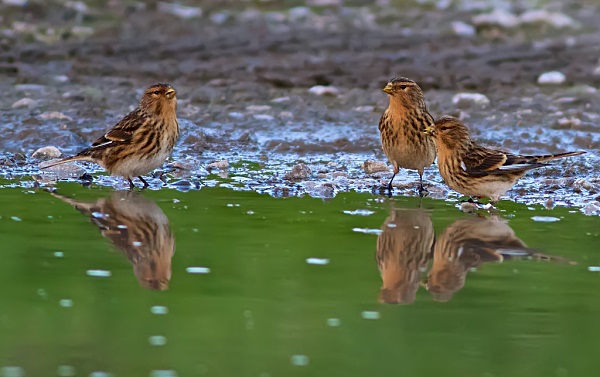
Strong winds early in the month blew in a Leach's Petrel, Great Northern Diver, a Pomarine Skua and 62 Gannets, more unexpected was a Black Tern off Point of Ayr. During a flat calm on the 23rd 250 Great Crested Grebes and 2,500 Common Scoter were counted from Hilbre, there were also two reports of single Velvet Scoters with two birds on the 16th.
Wader numbers have not been particularly high, the exception are Black-tailed Godwits with large numbers at both Point of Ayr and Thurstaston, a combined count of 6,250 on the 21st is just below the highest ever count for the estuary.
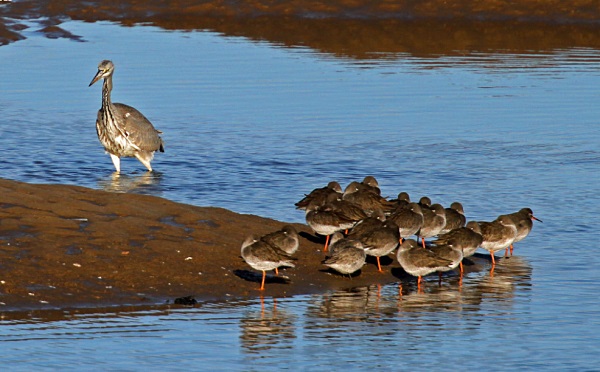
Richard Smith.
What to expect in December
Geese numbers are likely to carry on increasing and it is great that we have large numbers of Pink-footed Geese on the estuary - but they can be hard to spot with most on the far edge of the marsh, but they will be in view during the high tides early in the month. After the record count of 262 Brent Geese at West Kirby at the end of 2011 numbers have rather plateaued out and even dropped, but whether this drop is real or just a consequence of the flock becoming very scattered and therefore difficult to count, I'm not sure. Anyway, we should see a flock of around 200 birds this month. Both Teal and Pintail are lovely ducks to see, and there will be good numbers of the former at Connah's Quay, and Thurstaston Shore at low tide is an excellent spot to see both species.
How many Knot we get depends on the weather, particularly if we get prolonged freezing temperatures along North sea coasts in which case we should get at least 30,000, a spectacular sight at low tide at Thurstaston and high tide at Point of Ayr, West Kirby and Hoylake. Purple Sandpipers will also increase in number with Hilbre and New Brighton the best places to see them, we can expect around 20 at both sites.
If we get calm conditions out to sea then you will be able to see the huge Great Crested Grebe flock off north Wirral and Hilbre, over 1,000 have been counted there in previous winters - one of the largest flocks in the country. Also look out for a small flock of Scaup, which will be a lot closer in than the grebes, as well as large numbers of Common Scoters along with divers, auks etc.
High Tides
So far this year we've not had any decent high tides to cover the marshes, maybe the high tides on Dec 4th to 6th will deliver but we will need a strong west wind to bring it anywhere near Parkgate. Things look far more promising for the first three months of 2014 and in order to give you reasonable notice I detail the best of the big tides below. Note that we would be reasonably confident that a 10m+ tide would cover the marsh at Parkgate, but it very much depends on the weather and even a 10.2m tide with an easterly wind and high pressure is unlikely to make it. For more details and links see the Tides page. Times and heights are for Liverpool Gladstone Dock as per Laver's Tide Table.Jan 3rd 1213hrs 10.1m
Jan 4th 1301hrs 10.1m
Feb 1st 1200hrs 10.2m
Feb 2nd 1245hrs 10.2m
Feb 3rd 13.29hrs 10.0m
Mar 2nd 1142hrs 10.1m
Mar 3rd 1224hrs 10.0m
Top of Page
Forthcoming Events
December Highest Spring Tides (Liverpool)
Also
see Tides
page.
4th December, 11.36hrs (GMT), 9.9m.
5th December, 12.24hrs (GMT), 9.9m.
6th December, 13.12hrs (GMT), 9.8m.
Forthcoming Events
Organised by the Wirral
Ranger Service , Flintshire Countryside Service and/or the
RSPB:
All these events and walks have bird interest, even those not
advertised specifically for birdwatching. No need to book for these
events unless specified - please check below.
Also see 2013 Events Diary.
Parkgate Marsh is one of the best wetland habitats in the northwest, and when it is flooded by an incoming Spring high tide, the wildlife which lives here is pushed closer, potentially delivering an awe-inspiring spectacle. Join us at the Donkey Stand on The Parade, where we'll be set up with our marquee and telescopes hoping for the right weather conditions to really push the tide in.
You can expect great views of the large numbers of wintering wildfowl and waders shifting around to avoid the rising water, whilst the small mammals living on the marsh are flushed from cover, offering a feeding frenzy for the kestrels, harriers and short-eared owls.
It is recommended to arrive at least one hour before high tide.
High tide details: Wednesday 4 December, 9.9 m (32.4 ft) at 11.36 am; Thursday 5 December, 9.9 m (32.5 ft) at 12.24 pm; Friday 6 December, 9.8 m (32.1 ft) at 1.12 pm.
Saturday 7th December - 12:00noon start, high tide 1345hrs.
High Tide Birdwatch at Hoylake:
Join the Coastal Rangers, the Dee Estuary Voluntary Wardens and the RSPB to see the large numbers of wading birds on Hoylake beach. With a rising tide, we should see the birds at close quarters as they roost and feed. Beginners welcome. Dress warmly and bring binoculars if you have them.
Meet on the promenade at King's Gap, Hoylake.
For further information, contact the Coastal Rangers on 0151 648 4371.
Saturday 14th December 12:00 noon – 2:30pm
Take Tea on Hilbre with the RSPB
Walk across the sands to Hilbre Island where the RSPB will be serving tea and biscuits during the above date and time. They will be on hand to show you the island’s unique wildlife and will tell you about the work that the RSPB are doing at their fantastic reserve at Burton Mere Wetlands. There is no need to book, just turn up. Suitable clothing and footwear are essential for the walk out and please note – this is not a guided walk. Remember to bring money for the tea!
For further information, please telephone (0151) 648 4371.
Saturday 4th January - 11:00am start, 1250pm high tide.
High Tide Birdwatch at Hoylake:
Join the Dee Estuary Voluntary Wardens and the RSPB to see the large numbers of wading birds on Hoylake beach. With a rising tide, we should see the birds at close quarters as they roost and feed. Beginners welcome. Dress warmly and bring binoculars if you have them.
Meet on the promenade at King's Gap, Hoylake.
For further information, contact the Coastal Rangers on 0151 648 4371.
Saturday 11th January 11:00am – 2:30pm
Take Tea on Hilbre with the RSPB
Walk across the sands to Hilbre Island where the RSPB will be serving tea and biscuits during the above date and time. They will be on hand to show you the island’s unique wildlife and will tell you about the work that the RSPB are doing at their fantastic reserve at Burton Mere Wetlands. There is no need to book, just turn up. Suitable clothing and footwear are essential for the walk out and please note – this is not a guided walk. Remember to bring money for the tea!
For further information, please telephone (0151) 648 4371.
